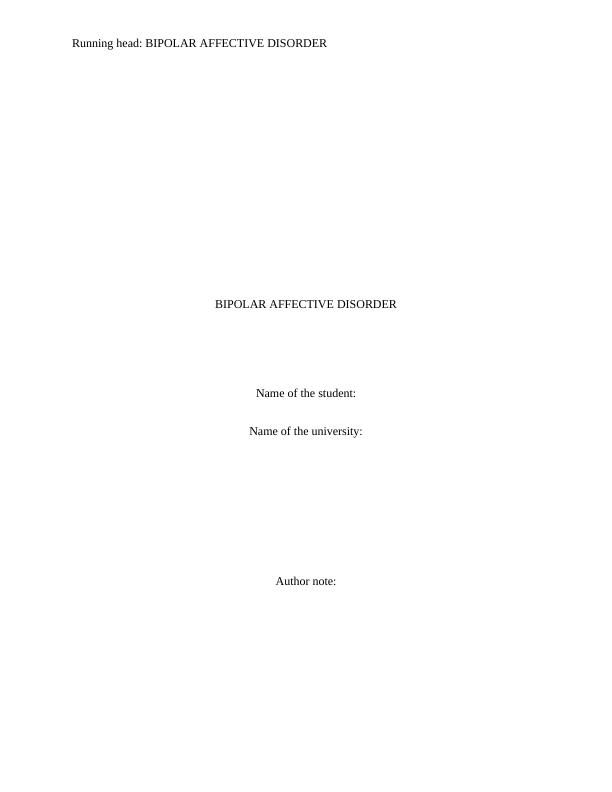(PDF) Bipolar Affective Disorder
Added on 2021-04-16
8 Pages2099 Words43 Views
Running head: BIPOLAR AFFECTIVE DISORDERBIPOLAR AFFECTIVE DISORDERName of the student:Name of the university:Author note:

1BIPOLAR AFFECTIVE DISORDERIntroduction:Mental disorders can be defined as the disorders that cause mild to severe disturbances inbehavior as well as thought process of individuals. This illness results the individuals to sufferfrom inability to cope with different ordinary demands and routines of daily life and the differentsituations that arise in life. Researchers had noted more than 200 different classified forms ofmental health illness (Hayes et al. 2015). These disorders tend to affect the quality of life ofindividuals all over the nation. Therefore, it becomes important for such individuals to takesupport form healthcare professionals and follow their interventions to come back to normallives. This assignment will depict one such disorder like bipolar affective depression and willdiscuss its symptoms and risk factors. It will also show the different interventions that could beused by the nursing professionals to help patients overcome the disorders and lead normal lives.The disorder and its impact on the service users and family members:Bipolar affective (maniac) disorder can be identified by prolonged, deep as well asprofound depressive periods. Such periods alternate with excessively elevated and irritablemoods that are termed as mania by researchers. Researchers have also stated that manic episodescontinue in affected individuals for at least one week of continuous mood disturbance. Thisdisorder is also characterized by expansiveness, elation as well as irritability (Upthegrove et al.2015). Different symptoms are often noted in individuals like grandiosity ad clear evidence ofdistractibility. Other symptoms mainly comprise of diminished need for sleep as well aspressured speech and excessive talking. Flight of ideas as well as racing thoughts is also noticedin such individuals. Such individuals are also seen to exhibit enhanced level of different types ofgoal-focused activities at home as well as work. Loss of energy, fatigue, significant weight loss,decreased concentration, preoccupation with death or suicide and others are symptoms shown by

2BIPOLAR AFFECTIVE DISORDERsuch individuals. The family members get depressed and anxious about the condition of theirpatient who suffers from this disorder. Their caregiver feels a restricted life, as they have to carefor their patient and feels physically and emotionally strained. Therefore, more effective thetreatment of the patient, the family members can also have better quality lives.Diagnosis:Researchers are of the opinion that the most significant risk factor for the disorder is afamily history of either BPAD or depression. About two thirds of the patients with BPAD havebeen found to have some forms of family history of mental illness. Researchers are still beenconducted to find or more information about how genetics as well as family history iscontributing to the occurrence of the disorder (Glanz 2014). Doctors who conduct diagnosismainly look for certain symptoms for confirmation. These are inappropriate spending, less needfor sleep, poor judgment, increase in goal directed activities and others (Scubert, Focking andCotter 2015). When patients come with depression, doctors diagnose them who look for loss ofpleasure, social withdrawal, low mood, decreased libido, weight loss and poor sleep. In order torule out chances of other disorders, healthcare professionals conduct differential diagnosis. Theyconduct thyroid tests, tests for HIV or syphilis infection, calcium levels, electrocephalogram (torule out epilepsy), CT scan (to rule of brain injury) and many others. All these help thehealthcare professionals to diagnose and confirm the disorders (Mehta et al. 2014).Health belief model:The nursing professionals follow the health belief model to help the patients overcomethe symptoms of the disorders. With the help of this model, the professional can help patients tobe motivated to carry out preventive health behaviors in response to a perceived threat (Green

End of preview
Want to access all the pages? Upload your documents or become a member.
Related Documents
Bipolar Disorder: A Guide for Patients and Family Memberslg...
|25
|1936
|94
Mental Health: Case Studies of Jenny and Marisollg...
|10
|2463
|499
Psychopharmacology Caselg...
|18
|1061
|62
Implementing Psychoeducation for Bipolar Disorder Management in Psychiatric Wardlg...
|37
|10904
|259
Depression: Types, Symptoms, and Caregiver Instructionslg...
|5
|1216
|77
Mental Health: Care Options for Bipolar Disorder Patientlg...
|10
|3268
|73
